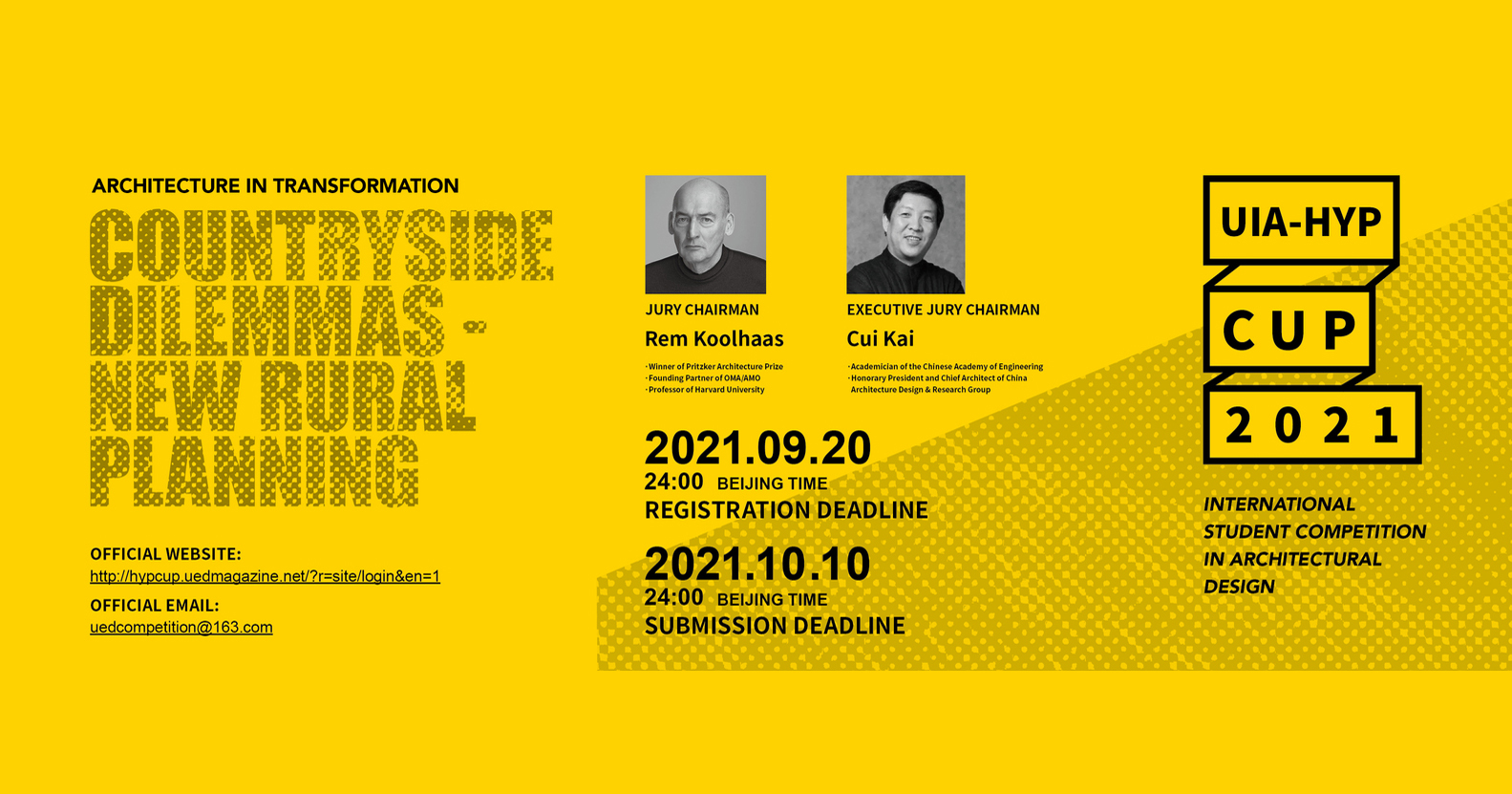Summary: The advent of the year of the Ox brought destruction to the ancient village of Wongding in Yunnan, which has been recognized as important cultural countryside heritage since 2006. This competition asks to submit the best ideas and or the best case studies examples that challenge existing planning tradition to collectively build a library of the most relevant and interesting possibilities to give a new fundamentally revised view of the future of the countryside.
Description:
Theme: Architecture in Transformation
Topic: Countryside Dilemmas-New Rural Planning
Jury Chairman: Rem Koolhaas
Registration Deadline: 24:00(GMT+8) September 20th, 2021
Submission Deadline: 24:00(GMT+8) October 10th, 2021
Jury Review: October 2021
The advent of the year of the Ox brought destruction to the ancient village of Wongding in Yunnan, which has been recognized as important cultural countryside heritage since 2006. The fire that raged through Wongding however exposed more fundamental dilemmas that go beyond replacing the village’s thatched roof tops and intricate wood constructions, which my team and I have been observing in many places in the world for some time now. It coincides with an important crossroads in thinking about the future of the countryside in China and beyond.
China’s rural development has been largely based on top-down industrial planning. Like in many places in the world this brought modernity to the countryside and offered dramatic improvements in the quality of life for many. It however also meant that historical, natural, and cultural quality concentrated in age old ways of living suffered. In 2020 the unprecedented anti-poverty campaigns in China that reshaped countrysides since the 1970s across the nation and specifically areas not unlike those we find in and around Wongding came to a first completion. This important milestone marks an important moment for reflection on this initial way of working not only for China: it demands new considerations on the future of planning the countryside.
China is not alone in this struggle. In the exhibition and book Countryside. The Future I showed with the AMO team and a large group of experts how far architecture has drifted from the countryside across the globe. From looming environmental disaster in Russia, the firm corporate grip of ruthless forms of Cartesianism in the West, to the larger global consequences of preservation and growing migration crises, we show that thinking and planning the countryside has never been more important for a shared future.
The old way of planning large swaths of countryside around the world was largely based on an industrial and material-based planning method or the narrow interests of markets. Both are up for reinvention. We also witness how conventional ways of defining heritage are buckling under pressure of packaged tourism, generating a hollowing of what we consider authentic. Combined with the new ambitious sustainability and rural revitalization goals, these are new milestones of a different nature, which need a new approach in it recognizing the quality of village life. Both the environment and the need for more sustainable ways of living urge us to rethink our relationships with nature and culture. It is also clear that a new generation wants a different form of interaction with the countryside. Informal tools and platforms like Chinese Rural Taobao, rural social media platform like Kwaisho, and small scaled technological and financial add-ons used in the Sub-Sahara, offer the start of a new toolkit for planning, framing, and experiencing the countryside: offering hybrid active lifestyles where countryside and urban activity generate a new blended life. Besides convenience and comfort, the authenticity of a ‘real’ experience and focus is paramount.
The countryside fundamentally challenges the paradigm of the architectural profession by requiring a more deeply ingrained role compared to being a city’s ‘service provider’. There might be no such thing as architecture related-information to fall back to. Rural context requires a skills set where economy, infrastructure, new and old technology, and culture have to work in unison, in order to generate new experiences. Solely mastering old arts and crafts will not bring the future that is needed.
Work in the countryside also challenges the notion of fixed construction plans. As many of the issues in the countryside are not exclusively solvable by construction alone, it must build more on an effective combination and spatial translation of new ideas, desires, methods and reference points rather than the orthodoxies of traditional planning. Within this context, the burning of Wongding, and all its cousins around the globe, should lead to a broader rejuvenation of the village in a new and striking 21st century way of rethinking planning, heritage, beauty, value, economy, development, and purpose.
We ask you to submit these ideas and or the best case studies examples that challenge existing planning tradition to collectively build a library of the most relevant and interesting possibilities to give a new fundamentally revised view of the future of the countryside.
PRIZE AND AWARD
1st Prize (1 team)
Certificate and 100,000 RMB (approx.15, 000 USD) (before tax);
2nd Prize (3 teams)
Certificate and 30,000 RMB (approx.4, 500 USD) (before tax);
3rd Prize (8 teams)
Certificate and 10,000 RMB (approx. 1, 500 USD) (before tax);
Honorable Mentions (several teams)
Honor Certificate
Advisors of prize-winning projects will also be awarded with certificates.
Organizations
International Supporter: Union International des Architectes(UIA)
Hosting Organizations: School of Architecture, Tianjin University, Urban Environment Design (UED) Magazine
Co-hosting Organization:School of Architecture, The Central Academy of Fine Arts
Advising Institutions:Chinese National Evaluation Committee of Higher Architecture Education, Architecture Art Committee of China Artists Association
Exclusive Naming Sponsor:Shanghai HYP-ARCH Architectural Design Consultant Inc.
Co-organizers:School of Architecture, Tsinghua University, College of Architecture and Urban Planning, Tongji University, School of Architecture, Southeast University, School of Architecture, South China University of Technology, School of Architecture, Xi’an University of Architecture and Technology, Faculty of Architecture and Urban Planning, Chongqing University
Download the information related to this competition here.


